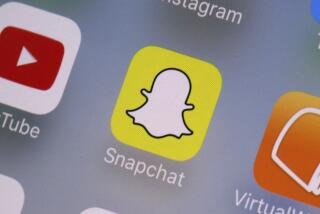China will drive mobile spending to record $380 billion in 2020

- Share via
Mobile app spending and usage hit a record in 2019 and show no signs of tapering off this year as faster cellular connections and more big-name video streaming services come online, industry tracker App Annie says.
China should again prove the biggest driver of consumption on everything from video streaming to games operated by social media giant Tencent Holdings Ltd., propelling spending 23% higher to $380 billion this year, App Annie researchers said. China made up half of all consumer spending in 2019 and was among the fastest-growing markets when it came to time spent on a mobile device. The global average is now 3.7 hours per person per day, according to the researchers.
Among the headline grabbers of 2019 was ByteDance Inc.’s video-sharing platforms including TikTok, which racked up 14.5 billion hours of time watched and grew its audience 200% in the fourth quarter. Nine out of every 10 minutes spent in the app have come from China, App Annie said. Google’s YouTube Music racked up even more impressive numbers, growing worldwide active users 870% over the 24 months ending Dec. 19.
“Year 2020 will mark the beginning of a mobile-first decade,” said Cindy Deng, managing director for Asia-Pacific at App Annie. “It’s imperative that brands start to adapt their strategy to this growing generation, or risk being left behind.”
In the past year, mobile apps accumulated $120 billion of global consumer spending, with games accounting for 72% of that. Advertising brought in $190 billion, said App Annie, forecasting the number to grow to $240 billion this year.
Generation Z — the cohort born after 1997 for whom mobile has become the first screen — is fueling the surge. Income from games continued to grow in 2019, when 1,121 mobile titles brought in more than $5 million in earnings, up from 959 two years prior. One hundred thirty-nine games went beyond $100 million in revenue for the year, up from 88 in 2017.
But non-gaming apps grew even faster, led primarily by subscription-based revenue models and a rabid appetite for entertainment.
In the U.S., App Annie found Apple Inc.’s iOS platform commanded 79% of non-gaming app revenue versus Google’s Android claiming 21%, with the majority on both platforms coming from subscriptions to the likes of Tinder and Netflix Inc.
The use of mobile finance apps doubled between 2017 and 2019, with users accessing such services 1.1 trillion times in the past year. This has been driven by mobile-first countries such as China, India and Brazil, while Indonesia, Japan and Russia are growing fastest when it comes to monthly active users. App Annie analysts said fintech apps designed specifically for mobile screens, such as Monzo or PayPal, were outperforming traditional banks because of their greater ease of use.
Entertainment apps also saw a 120% rise in use over the past two years, and in 2019 Netflix was joined by Apple TV+ and Walt Disney Co.’s Disney+ subscription streaming offerings. The competition will intensify as more mobile-centric services emerge: former HP Inc. Chief Executive Meg Whitman and film veteran Jeffrey Katzenberg’s Quibi, for instance, offers different video perspectives depending on how a phone is held.
Streaming content looks likely to be the big driver for the adoption of 5G networking among mobile users, as App Annie found it growing universally around the globe. On Android phones over the past two years, India streamed nearly 80% more, France and Japan were up more than 50% and the U.S., Canada and Indonesia all grew by more than 40%. Data consumption on streaming sports was up 80% over the same period, indicating a bandwidth-hungry market that’s far from hitting its consumption ceiling.
More to Read
Inside the business of entertainment
The Wide Shot brings you news, analysis and insights on everything from streaming wars to production — and what it all means for the future.
You may occasionally receive promotional content from the Los Angeles Times.










